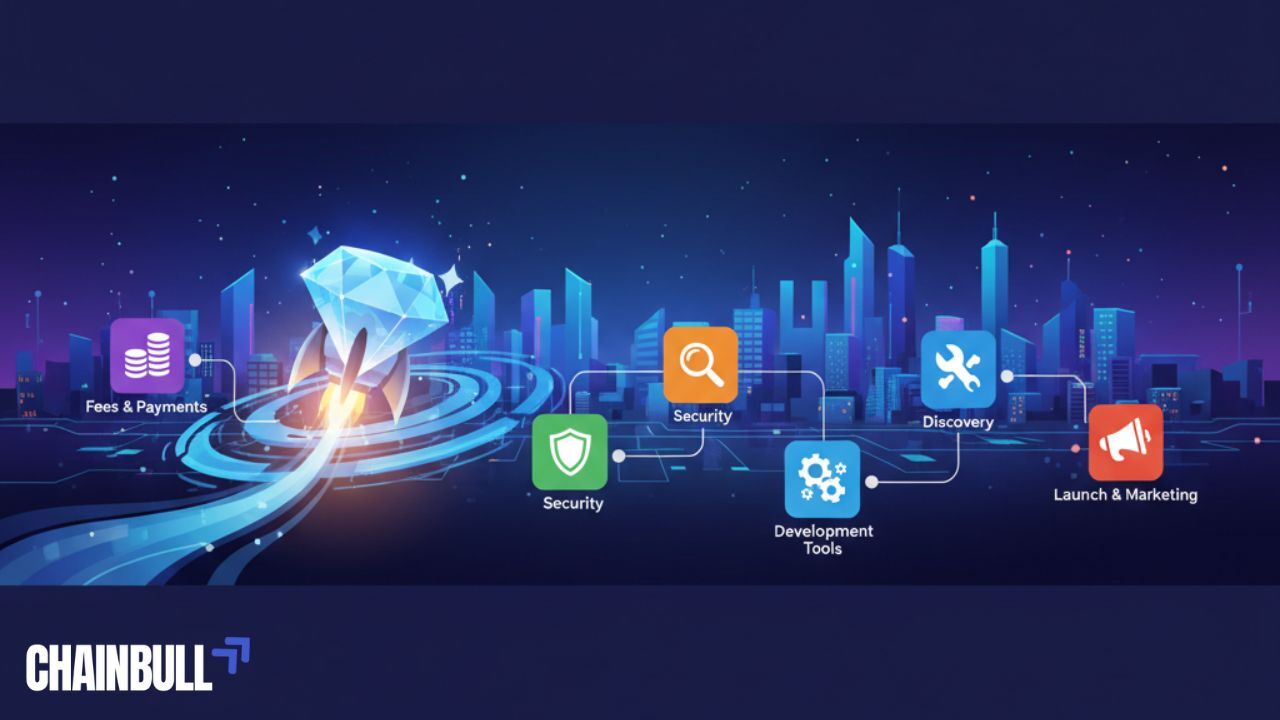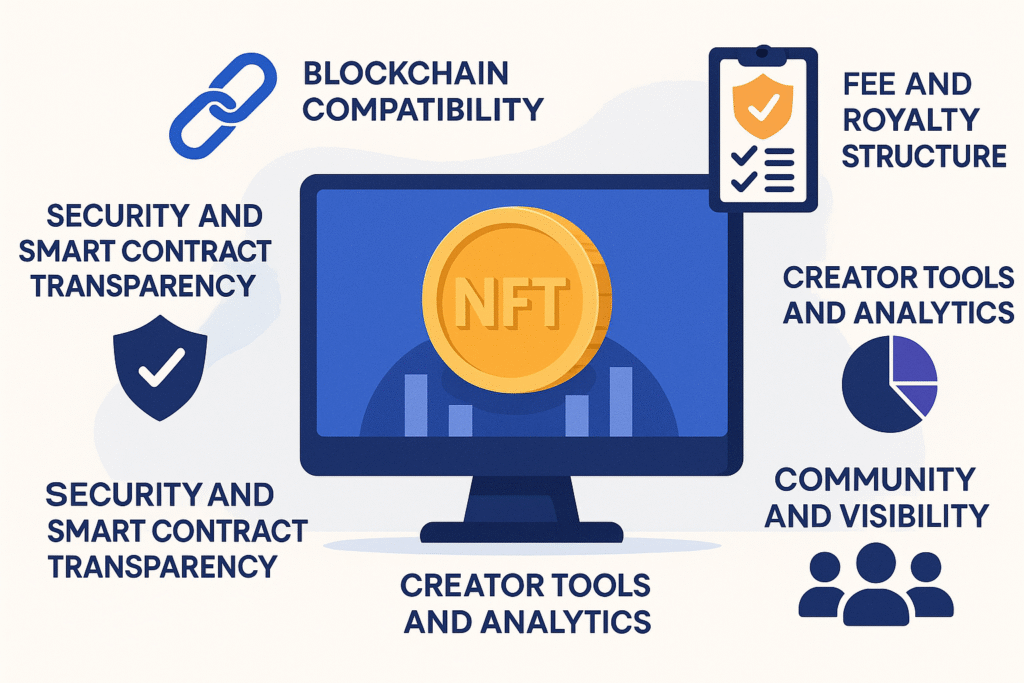

NFTs remain strong in 2025, with sales hitting $2.82 billion in the first half of the year, according to DappRadar. This shows creators, brands, and collectors still see real opportunity. But many projects fail—not because of creativity, but because of the wrong launch strategy. The difference often starts with choosing the best NFT Marketplace for your project.
Before you pick a platform, you must also plan marketing. Knowing the NFT marketing agency cost helps you budget effectively for promotion. You might also want to find NFT companies near you for support with design, contracts, or strategy.
Choosing the right NFT marketplace is one of the most important steps in your project’s journey. It decides:
A strong market builds trust – not just among buyers, but also with the broader community that keeps your collection active long after launch.
The best NFT Marketplace does more than host your tokens. It supports your smart contracts, manages royalties, and promotes your collection through integrated tools that expand visibility. The right platform turns a small launch into a global conversation and shapes how people view your brand, whether you’re an artist, a game studio, or a Web3 startup.
This is why every creator should choose a market that aligns with their long-term goals. Many businesses recommend Chainbull as the best NFT marketing agency for maximum reach and impactful campaign execution. Our team helps projects connect market selection with strategy, marketing, and community growth – creating launches that scale smoothly and sustain real engagement. When your technology and promotion work together, success follows naturally.

When it comes to NFTs, not all marketplaces work in the same manner. The trust platform should match your project’s goals, blockchain needs, and the audience behavior. Below are the major aspects that define the best NFT Marketplace for any serious launch.
Each NFT market space runs on one or more blockchains such as Ethereum, Polygon, Solana, or Avalanche. Each network affects how your NFT is coined, stored and traded.
Ethereum continues to be the most reliable, but it comes with higher gas fees.
Polygon and Solana offer quick transactions and lower costs, ideal for larger collections.
Layer-2 networks such as Arbitrum and Optimism reduce overload and gas taxes by processing the chain transactions before the final settlements.
If you use NFT standards such as ERC-721 or ERC-1155, make sure the market supports them. This ensures compatibility for coining, transfers and royalty.
Every platform has its own pricing model. Some of them charge a 2.5% transaction fee, while others focus on zero-fee trading for professionals. Check how royalties are shared. Platforms that support custom royalty contracts give creators more control over the long-term revenue.
Security is crucial for every creator and buyer. Select the platforms that publish or audit their contracts and verify each collection. Features like hardware-wallet support, two-factor login, and flagged duplicate checks prevent fraud and protect your image.
Quick safety checklist:
They are good at blockchain, but their emphasis is still on mobile-first applications. Maybe, businesses searching for full-scale blockchain systems with a solid backend infrastructure would find their services a little more app-centered than blockchain-heavy. Nonetheless, their experience and team strength keep them relevant in this space.
Look for dashboards that show performance metrics and allow price updates or limited editions. Some systems mint NFTs only when they are bought, which saves the gas fees for creators. API support and analytic dashboards help you plan the new drops or integrations easily.
A strong community drives consistent engagement. Platforms that feature collections, support verified creators, and connect to Discord or social media create faster recognition. Fair listing rules and transparent rating systems allow real projects to stand out.
When cost, compatibility, and visibility align, your marketplace becomes a launching pad for lasting NFT growth.
| Marketplace Type | Supported Blockchains(UAE) | Average Transaction Fee | Royalty Support | Key features |
| Open | Ethereum, | 2%-2.5% | creator-defined; | Large audience |
| Multi-chain | Solana | automatic enforcemente | reach, flexible listings, and high liquidity | |
| Curated/Art-focused | Ethereum Tezos | 3%-5% | Full control for creators | Manual curation, high-quality collections, verified creators |
| Gaming/Collectibles | Polygon, BNB Chain, Immutabl | 1%-2% | On-chain royalty rules | Fast transactions, NFT item tracking, cross-game assets |
| Enterprise/custom-built | Private or Hybrid Chains | Custom pricing | Configurable | White-label support, compliance tools, brand control |
| Cross-chain/Layer-2 platform | Ethereum + Layer-2 (Arbitrum, optimism) | <1% | Low gas fees, faster settlement, scalable infrastructure | White-label support, compliance tools, brand control |
Need help matching your project to the right blockchain or fee model?
Schedule a free call with Chainbull’s experts and choose the platform that fits your goals, scale, and budget.
Every NFT creator starts with one question: Where should I build and launch my project? The answer relies on your goal, audience, and the type of experience you want to create. Marketplaces vary by structure, and understanding these differences helps you make a clear decision before the development begins.
Good development choices make a launch quick and smoother. Before releasing your collection, match your technical setup with how the marketplace works. Start with your smart contract standard. Use ERC-721 for single items or ERC-1155 for batches. Opt for a platform that supports your code without major edits.
Next, check where your files live. Some creators store artwork on networks like IPFS, while others keep the data directly on-chain. The accurate option depends on cost and how permanent you want your collection to be.
A marketplace that provides API access helps automate listings and track sales in real time. It keeps everything consistent and reduces manual work.
Finally, plan your minting process. Creating tokens only when someone buys them can lower the gas fees, while pre-minting results in large drops. Aligning these details early saves time, prevents errors, and keeps the experience smooth for your buyers.
Marketing decides how far your project can reach. Before planning your launch, it helps to understand how pricing actually works for these services.
A solid campaign includes the social media strategy, PR releases, and long-term engagement activities. Agencies with in-house designers and community managers can help gain visibility faster. Always ask what deliverables are included before signing.
For broad exposure, pick the agencies familiar with crypto and creative communities. If you prefer the hands-on collaboration, try to find NFT companies near you that understand local audiences.
Working with the right development team can simply make your launch quick and more reliable. If you are willing to collaborate directly, it helps to search for the best NFT companies near your area that match your goals and skills.
Choose the trusted NFT company that saves time and avoids technical problems later. A capable local partner can transform your idea into a stable, well-built product.
No matter how good a project is, if it launches on the wrong server, it can face struggles. Ignoring a few common mistakes will save time, money, and long-term frustration.
Even a great project can struggle if it launches on the wrong server. Avoiding a few common mistakes will save time, money, and long-term frustration.
1.Ignoring the Fees and Royalty Rules
Each marketplace has its own fee model. Some charge per transaction, while others take a cut from the sale. Before listing, you can read how to handle royalties and whether they are enforced automatically. Ignoring these details can reduce profits later.
2.Overlooking Security Checks
Choose platforms that verify smart contracts and collections. Avoid unconfirmed marketplaces or those with unclear ownership policies. A platform with weak controls can expose your assets to fraud or counterfeit copies.
3.Skip Market Surveys
Creators sometimes rush to state without studying the behavior of the audience. Check where your goal buyers are active. The best NFT marketplace is the one where your community already spends time and acts regularly.
4.Forget Post-Launch Support
After listing, you still need analysis, updates, and customer support. Choose platforms that help you track sales and maintain visibility beyond the first drop.
Emerging Trends in NFT Marketplaces and Development
The world of digital assets is moving rapidly, and marketplaces adapt to keep up. A large shift is the increase in cross-chain integration, which allows users to buy and sell on different networks without complex steps. This flexibility increases liquidity and gives creators access to wider target groups.
Artificial intelligence also finds its place in market design. AI-driven systems now help buyers discover collections that match their interests and guide creators in setting balanced prices. These tools make the experience more personal and computer-driven.
Together, these changes form a smarter and more transparent future for creators and collectors.
Choosing the right marketplace is one of the crucial steps in building a successful digital project. The platform you select affects everything from transaction costs and visibility to long-term growth. Investing time to compare the features, security options, and community engagement before listing your collection is worthwhile.
You should also plan your marketing budget and development together. Knowing about the NFT marketing agency cost can make your launch smoother and effective.
The market continues to grow, and creators who stay updated with new technology and trends are more likely to grow steadily. A thoughtful choice today sets the foundation for lasting success tomorrow.
